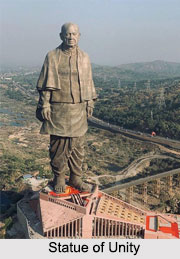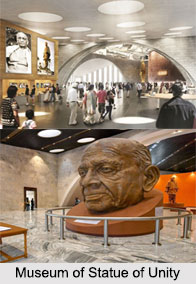 Statue of Unity is a colossal statue dedicated to the "Iron Man of India", Sardar Vallabhbhai Patel. It is a tribute to the man who united India. The Statue of Unity was inaugurated by Prime Minister Narendra Modi on October 31, 2018. Built in less than 5 years, it is the world"s tallest, grandest and giant statue at 182 metres, leaving China"s Spring Temple Buddha at 153 metre, a long way behind.
Statue of Unity is a colossal statue dedicated to the "Iron Man of India", Sardar Vallabhbhai Patel. It is a tribute to the man who united India. The Statue of Unity was inaugurated by Prime Minister Narendra Modi on October 31, 2018. Built in less than 5 years, it is the world"s tallest, grandest and giant statue at 182 metres, leaving China"s Spring Temple Buddha at 153 metre, a long way behind.
Location of Statue of Unity
The Statue of Unity stands tall atop Sadhu Bet Island on the Narmada River facing the Sardar Sarovar Dam downstream in Kevadiya Colony, about a 100 kilometres southeast of Vadodara, Gujarat.
Aim of the Statue of Unity
Sardar Vallabhbhai Patel is renowned as the architect of Independent India, as he united all diverse 562 Princely States of India to build one great Republic of India. Shri Narendra Modi decided to pay honourable tribute which will be cherished for centuries by the whole world and it will become a matter of pride for every Indian for this great man.
 Design and Construction of Statue of Unity
Design and Construction of Statue of Unity
The Statue of Unity is conceived as a naturalistic depiction of Sardar Vallabhbhai Patel in a walking pose. The specifications of the structure stand at a height of 240 metres from the base, where height of the base is 58 metres and height of statue is 182 metres. It rises out of a star-shaped, geometric base that covers the entire Sadhu Hill. A viewing gallery at the 135 m level, at the chest, can accommodate up to 200 visitors at one go and affords a breath-taking view of the dam and its environs. The Statue of Unity was designed by Indian sculptor, Ram Vanji Suthar, a Padma Bhushan and Padma Shri Awardee for his contribution in the field of arts.
Viewing Gallery and Museum of Statue of Unity
The Statue of Unity is divided into five zones. Of the five zones the statue is segregated into only three that are open to public viewing.
Zone 1: The first level entails the base going all the way to the statue"s shins. It comprises a museum cataloguing Sardar Vallabhbhai Patel"s contributions, and a memorial garden.
Zone 2: This goes up to the statue"s thighs at 149 metres.
Zone 3: This extends up to the viewing gallery at 153 metres. A viewing gallery that affords expansive views of the Narmada River and the surrounding Satpura and Vindhya Ranges.
Zone 4: This serve as the maintenance area.
Zone 5: This is the highest level that comprises the head and shoulders of the statue.
How to Reach Statue of Unity
Statue of Unity is about a 100 kilometre from Vadodara, Gujarat. The Vadodara Airport is about 90 kilometres away from the site and Vadodara railway station is the nearest rail head to the statue. One can get on the public transport or hire a cab to get to the Statue of Unity.
Statue of Unity has attracted a large number of tourists since its grand inauguration. During the first 11 days of its opening, the monument drew around 1.3 lakh tourists. According to the State Government, 15,000 visitors visit the statue every day on an average.



















